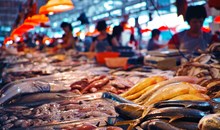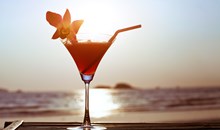Cape Verde
Copyright: Frank Bach / Shutterstock.comCape Verde
Cape Verde's unique geographic location, tumultuous history of slavery and invasion, and fascinating mix of transatlantic cultures have given rise to a place unlike any other on the globe. A place as joyful as it is full of longing, a fact perhaps best reflected in Cape Verdean music and the hauntingly beautiful "morna". The sometimes harsh, drought-prone conditions of this mid-Atlantic scattering of islands have seen the flourishing of a fascinating Creole culture and the most stable democracy in Africa.The Islands
Off the western coast of Africa, almost exactly halfway between Portugal and Brazil, lies a volcanic archipelago of breathtaking natural beauty and sobering historical tragedy. The terrain ranges from barren and rocky volcanic backdrops to lush topical forests, with white and gold beaches and indigo seas. Equally varied is the cultural heritage of the islands' inhabitants, a Portuguese-African Creole with ties to the Caribbean, as much Sao Paulo and Kingston as it is Dakar and Lisbon, a fact reflected in their speech, their music, their cooking and their general outlook on life and 'morabeza', the hallmark Cape Verdean hospitality. The 10 islands that make up the archipelago (nine of which are currently inhabited) are rather charmingly laid out in the shape of an arrow, pointing southeast towards the Senegalese coast. Sal is the main island for tourists, with the city of Santa Maria offering plenty of resorts, restaurants and fine shopping, while Sao Vicente (and in particular the city of Mindelo) is the country's cultural hub. Santiago is home to the capital, Praia, and the main port, which handles most of the commercial and passenger vessels traveling to and from the islands. Visitors would do well to explore as much of the archipelago as possible, as each island is a world unto itself, deserving of our admiration and awe.Do & See
Adventure awaits amidst the rugged beauty of the Cape Verde islands. Thrill-seekers come from around the globe for first-class windsurfing and game fishing, to gape at the underwater marvels while diving and snorkeling and to admire the islands from atop an active volcano after a full-day hike. But there is plenty in the way of leisure, as well, with pristine golden beaches and a burgeoning resort infrastructure. Be sure, however, not to miss the historical wonders to be found at Cidade Velha and among the streets of Praia and Mindelo.
Dining
Seafood abounds in Cape Verde, with delicacies like grilled lobster, tuna, and octopus featuring on most menus, as well as Creole and Portuguese specialities. The most representative typical dish is the 'cachupa' (pictured above), a filling mix of maize, beans, sweet potato and chicken or meat. The larger towns offer an increasingly wide variety of restaurants and cuisines, but on smaller islands, many places will be limited to the lunch of the day ('prato do dia'), which usually includes the freshest catches. Here are the top places to eat while in Cape Verde:
Cafes
Most Cape Verdean cafes double as restaurants or bars, so you can often eat, drink, and have dessert at the same place. Pastries are particular highlights here, many following the Portuguese traditions, as are the jams ('doce') made from local exotic fruits, often served with goat cheese for dessert. There is a steadily increasing selection of cafes to be found in the major towns and near popular beach areas. Below are the best cafes in Cape Verde:
Bars & Nightlife
Nightlife in Cape Verde moves to the sounds of 'morna', a beautiful form of folk music that fully captures the country's rich history and mix of cultural influences. In taverns around the islands, people gather after dark to hear the mournful sounds of singers accompanied by guitars, violins, and pianos. More joyful melodies come from the islands' other genres of 'funaná', 'batuque', and 'coladeira', all of which liven up a nightlife scene that lives and breathes music and tradition.
Shopping
Most everyday products in Cape Verde are imported, and thus tend to be on the expensive side, but locally-produced items are plentiful, and strolling through the stalls at any of the islands' vibrant markets is an experience not to be missed. Find fresh produce and fish, local coffee, cheese and jam, wine, rum and the traditional grogue, and of course, a wealth of handicrafts and artwork, including wood carvings, woven baskets, paintings and jewellery.

 Copyright: Erik Kristensen / Wikimedia Commons
Copyright: Erik Kristensen / Wikimedia Commons
 Copyright: Samuel Borges Photography / Shutterstock.com
Copyright: Samuel Borges Photography / Shutterstock.com
 Copyright: Frank Bach / Shutterstock.com
Copyright: Frank Bach / Shutterstock.com
 Copyright: Styve Reineck / Shutterstock.com
Copyright: Styve Reineck / Shutterstock.com
 Copyright: Sabine Hortebusch / Shutterstock.com
Copyright: Sabine Hortebusch / Shutterstock.com
 Copyright: luis abrantes / Shutterstock.com
Copyright: luis abrantes / Shutterstock.com
 Copyright: David Stanley / Flickr
Copyright: David Stanley / Flickr
 Copyright: CorreiaPM / Wikimedia Commons
Copyright: CorreiaPM / Wikimedia Commons
 Copyright: Polly Dawson / Shutterstock.com
Copyright: Polly Dawson / Shutterstock.com
 Copyright: Samuel Borges Photography / Shutterstock.com
Copyright: Samuel Borges Photography / Shutterstock.com
 Copyright: LivetImages / Shutterstock.com
Copyright: LivetImages / Shutterstock.com
 Copyright: Dima Fadeev / Shutterstock.com
Copyright: Dima Fadeev / Shutterstock.com
 Copyright: PLRANG ART / Shutterstock.com
Copyright: PLRANG ART / Shutterstock.com
 Copyright: Lawrence Jackson / Shutterstock.com
Copyright: Lawrence Jackson / Shutterstock.com
 Copyright: Vladimir Krupenkin / Shutterstock.com
Copyright: Vladimir Krupenkin / Shutterstock.com
 Copyright: Yevgen Romanenko / Shutterstock.com
Copyright: Yevgen Romanenko / Shutterstock.com
 Copyright: thieury / Shuttestock.com
Copyright: thieury / Shuttestock.com
 Copyright: Daniel Åhs Karlsson / Wikimedia Commons
Copyright: Daniel Åhs Karlsson / Wikimedia Commons
 Copyright: iko / Shutterstock.com
Copyright: iko / Shutterstock.com
 Copyright: Africa Studio / Shutterstock.com
Copyright: Africa Studio / Shutterstock.com
 Copyright: Salvador Aznar / Shutterstock.com
Copyright: Salvador Aznar / Shutterstock.com
 Copyright: Andrey Bayda / Shutterstock.com
Copyright: Andrey Bayda / Shutterstock.com
 Copyright: Luiz Rocha / Shutterstock.com
Copyright: Luiz Rocha / Shutterstock.com
 Copyright: Slawomir Fajer / Shutterstock.com
Copyright: Slawomir Fajer / Shutterstock.com
 Copyright: oneinchpunch / Shutterstock.com
Copyright: oneinchpunch / Shutterstock.com
 Copyright: iravgustin / Shutterstock.com
Copyright: iravgustin / Shutterstock.com
 Copyright: gresei / Shutterstock.com
Copyright: gresei / Shutterstock.com
 Copyright: Africa Studio / Shutterstock.com
Copyright: Africa Studio / Shutterstock.com
 Copyright: Rui Ornelas / Flickr
Copyright: Rui Ornelas / Flickr
 Copyright: Pinkcandy / Shutterstock.com
Copyright: Pinkcandy / Shutterstock.com
 Copyright: rakratchada / Shutterstock.com
Copyright: rakratchada / Shutterstock.com
 Copyright: Salvador Aznar / Shutterstock.com
Copyright: Salvador Aznar / Shutterstock.com
 Copyright: Shebeko / Shutterstock.com
Copyright: Shebeko / Shutterstock.com
 Copyright: Slawomir Fajer / Shutterstock.com
Copyright: Slawomir Fajer / Shutterstock.com
 Copyright: Natalia Mylova / Shutterstock.com
Copyright: Natalia Mylova / Shutterstock.com
 Copyright: Gtranquillity / Shutterstock.com
Copyright: Gtranquillity / Shutterstock.com
 Copyright: PopTika / Shutterstock.com
Copyright: PopTika / Shutterstock.com
 Copyright: Viktor1 / Shutterstock.com
Copyright: Viktor1 / Shutterstock.com
 Copyright: Meik / Shutterstock.com
Copyright: Meik / Shutterstock.com
 Copyright: Ditty_about_summer / Shutterstock.com
Copyright: Ditty_about_summer / Shutterstock.com
 Copyright: 5PH / Shutterstock.com
Copyright: 5PH / Shutterstock.com
 Copyright: iravgustin / Shutterstock.com
Copyright: iravgustin / Shutterstock.com
 Copyright: Sergei Bachlakov / Shutterstock.com
Copyright: Sergei Bachlakov / Shutterstock.com
 Copyright: wavebreakmedia / Shutterstock.com
Copyright: wavebreakmedia / Shutterstock.com
 Copyright: In Green / Shutterstock.com
Copyright: In Green / Shutterstock.com
 Copyright: Rui Ornelas / Flickr
Copyright: Rui Ornelas / Flickr
 Copyright: Anneke Swanepoel / Shutterstock.com
Copyright: Anneke Swanepoel / Shutterstock.com
 Copyright: Sopotnicki / Shutterstock.com
Copyright: Sopotnicki / Shutterstock.com
 Copyright: Africa Studio / Shutterstock.com
Copyright: Africa Studio / Shutterstock.com
 Copyright: Monkey Business Images / Shutterstock.com
Copyright: Monkey Business Images / Shutterstock.com
 Copyright: Lisa S. / Shutterstock.com
Copyright: Lisa S. / Shutterstock.com
 Copyright: Stone36 / Shutterstock.com
Copyright: Stone36 / Shutterstock.com
 Copyright: EugeniaSt / Shutterstock.com
Copyright: EugeniaSt / Shutterstock.com
 Copyright: Zachary Staines / unsplash.com
Copyright: Zachary Staines / unsplash.com
 Copyright: Oleg V. Ivanov / Shutterstock.com
Copyright: Oleg V. Ivanov / Shutterstock.com
 Copyright: Juan Garces
Copyright: Juan Garces
 Copyright: Pierre-Luc Auclair
Copyright: Pierre-Luc Auclair
 Copyright: ArrivalGuides
Copyright: ArrivalGuides
 Copyright: ArrivalGuides
Copyright: ArrivalGuides
 Copyright: Andy Fuchs
Copyright: Andy Fuchs
 Copyright: Gemma Garner
Copyright: Gemma Garner
 Copyright: Jardson Almeida
Copyright: Jardson Almeida
 Copyright: Stirling Tschan
Copyright: Stirling Tschan